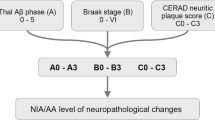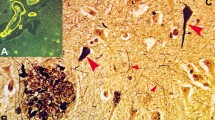Abstract
The diagnostic hallmarks of hippocampal sclerosis (HS) are severe volume loss of the hippocampus, severe neuronal loss, and reactive gliosis involving primarily two especially vulnerable fields, CA1 and the subiculum. Occasionally, HS may be the only neuropathological change detected in older individuals with dementia and is known as pure HS. In the majority of cases, HS occurs in the setting of other degenerative changes, usually Alzheimer’s disease (AD). In these cases, it is classified as combined HS. Although a clinical profile for HS has been identified, its similarities with AD make the diagnosis during life quite challenging; thus, the diagnosis is often made postmortem. The pathogenesis of HS is not completely understood, but the strong association with transactive response DNA-binding protein 43 (TDP-43), in approximately 90 %, and the recent discovery of genetic risk factors are important contributions to a better understanding of the disease process.

Similar content being viewed by others
References
Papers of particular interest, published recently, have been highlighted as: • Of major importance
Blumcke I, Thom M, Aronica E, et al. International consensus classification of hippocampal sclerosis in temporal lobe epilepsy: a Task Force report from the ILAE Commission on Diagnostic Methods. Epilepsia. 2013;54(7):1315–29.
Sommer W. Erkrankung des Ammonshorns als aetiologisches Moment der Epilepsie. Archiv für Psychiatrie und Nervenkrankheiten. 1880;10(3):631–75.
Teitelbaum JS, Zatorre RJ, Carpenter S, et al. Neurologic sequelae of domoic acid intoxication due to the ingestion of contaminated mussels. N Engl J Med. 1990;322:1781–7.
Ala TA, Beh GO, Frey 2nd WH. Pure hippocampal sclerosis: a rare cause of dementia mimicking Alzheimer’s disease. Neurology. 2000;54:843–8.
Amador-Ortiz C, Lin WL, Ahmed Z, et al. TDP-43 immunoreactivity in hippocampal sclerosis and Alzheimer’s disease. Ann Neurol. 2007;61:435–45.
Beach TG, Sue L, Scott S, et al. Hippocampal sclerosis dementia with tauopathy. Brain Pathol. 2003;13:263–78.
Hatanpaa KJ, Raisanen JM, Herndon E, et al. Hippocampal sclerosis in dementia, epilepsy, and ischemic injury: differential vulnerability of hippocampal subfields. J Neuropathol Exp Neurol. 2014;73:136–42.
Corey-Bloom J, Sabbagh MN, Bondi MW, et al. Hippocampal sclerosis contributes to dementia in the elderly. Neurology. 1997;48:154–60.
Hedreen J, Barr A, Devanny M, Price DL, Folstein MF. Hippocampal sclerosis (HS): a progressive dementia. J Neuropathol Exp Neurol. 1993;52:291.
Leverenz JB, Agustin CM, Tsuang D, et al. Clinical and neuropathological characteristics of hippocampal sclerosis: a community-based study. Arch Neurol. 2002;59:1099–106.
Pletnikova O, Sloane KL, Renton AE, et al. Hippocampal sclerosis dementia with the C9ORF72 hexanucleotide repeat expansion. Neurobiol Aging. 2014;35:2419 e2417–2421.
Dickson DW, Baker M, Rademakers R. Common variant in GRN is a genetic risk factor for hippocampal sclerosis in the elderly. Neurodegener Dis. 2010;7:170–4.
Josephs KA, Murray ME, Whitwell JL, et al. Staging TDP-43 pathology in Alzheimer’s disease. Acta Neuropathol. 2014;127:441–50.
Nelson PT, Smith CD, Abner EL, et al. Hippocampal sclerosis of aging, a prevalent and high-morbidity brain disease. Acta Neuropathol. 2013;126:161–77.
Nag S, Yu L, Capuano AW, et al. Hippocampal sclerosis and TDP-43 pathology in aging and Alzheimer disease. Ann Neurol. 2015;77:942–52. This study assesses the role of TDP-43 in cognitive decline, showing that the presence of TDP-43 is associated with a greater cognitive decline. Subjects with TDP-43 without HS had impairment in episodic memory only.
Barker WW, Luis CA, Kashuba A, et al. Relative frequencies of Alzheimer disease, Lewy body, vascular and frontotemporal dementia, and hippocampal sclerosis in the State of Florida Brain Bank. Alzheimer Dis Assoc Disord. 2002;16:203–12.
Onyike CU, Pletnikova O, Sloane KL, Sullivan C, Troncoso JC, Rabins PV. Hippocampal sclerosis dementia: an amnesic variant of frontotemporal degeneration. Dement Neuropsychol. 2013;7:83–7.
Probst A, Taylor KI, Tolnay M. Hippocampal sclerosis dementia: a reappraisal. Acta Neuropathol. 2007;114:335–45.
Zarow C, Weiner MW, Ellis WG, Chui HC. Prevalence, laterality, and comorbidity of hippocampal sclerosis in an autopsy sample. Brain Behav. 2012;2:435–42.
Toledo JB, Arnold SE, Raible K, et al. Contribution of cerebrovascular disease in autopsy confirmed neurodegenerative disease cases in the National Alzheimer’s Coordinating Centre. Brain : J Neurol. 2013;136:2697–706.
Alpers BJ, Berry RG, Paddison RM. Anatomical studies of the circle of Willis in normal brain. AMA Arch Neurol Psychiatry. 1959;81:409–18.
Nelson PT, Schmitt FA, Lin Y, et al. Hippocampal sclerosis in advanced age: clinical and pathological features. Brain : J Neurol. 2011;134:1506–18. A large cohort composed by 1004 controls and 106 autopsy-verified HS cases with longitudinal clinical data. They had important findings related to pathology, showing a strong association between HS and TDP-43 pathology; and also in the clinical field, comparing verbal fluency and episodic memory between HS and AD subjects.
Lee EB, Lee VM, Trojanowski JQ. Gains or losses: molecular mechanisms of TDP43-mediated neurodegeneration. Nat Rev Neurosci. 2012;13:38–50.
Mackenzie IR, Frick P, Neumann M. The neuropathology associated with repeat expansions in the C9ORF72 gene. Acta Neuropathol. 2014;127:347–57.
McKee AC, Gavett BE, Stern RA, et al. TDP-43 proteinopathy and motor neuron disease in chronic traumatic encephalopathy. J Neuropathol Exp Neurol. 2010;69:918–29.
Troakes C, Maekawa S, Wijesekera L, et al. An MND/ALS phenotype associated with C9orf72 repeat expansion: abundant p62-positive, TDP-43-negative inclusions in cerebral cortex, hippocampus and cerebellum but without associated cognitive decline. Neuropathol : Off J Jpn Soc Neuropathol. 2012;32:505–14.
Yokota O, Davidson Y, Bigio EH, et al. Phosphorylated TDP-43 pathology and hippocampal sclerosis in progressive supranuclear palsy. Acta Neuropathol. 2010;120:55–66.
Brenowitz WD, Monsell SE, Schmitt FA, Kukull WA, Nelson PT. Hippocampal sclerosis of aging is a key Alzheimer’s disease mimic: clinical-pathologic correlations and comparisons with both Alzheimer’s disease and non-tauopathic frontotemporal lobar degeneration. J Alzheimer’s Dis : JAD. 2014;39:691–702. A large sample, using NACC data, composed by 1422 subjects (118 HS cases), with pathological and longitudinal clinical data, showed that HS patients have a later age at onset, later age at death and milder clinical course compared to AD subjects.
Wilson RS, Yu L, Trojanowski JQ, et al. TDP-43 pathology, cognitive decline, and dementia in old age. JAMA Neurol. 2013;70:1418–24.
Zarow C, Wang L, Chui HC, Weiner MW, Csernansky JG. MRI shows more severe hippocampal atrophy and shape deformation in hippocampal sclerosis than in Alzheimer’s disease. Int J Alzheimers Dis. 2011;2011:483972.
Dickson DW, Davies P, Bevona C, et al. Hippocampal sclerosis: a common pathological feature of dementia in very old (> or = 80 years of age) humans. Acta Neuropathol. 1994;88:212–21.
Neltner JH, Abner EL, Baker S, et al. Arteriolosclerosis that affects multiple brain regions is linked to hippocampal sclerosis of ageing. Brain : J Neurol. 2014;137:255–67. This study found a strong association between HS and arteriolosclerosis, based on a sample of 2018 subjects (226 HS cases). And no association with large vessel cerebrovascular pathology or clinical vascular risk factors.
Van Deerlin VM, Sleiman PM, Martinez-Lage M, et al. Common variants at 7p21 are associated with frontotemporal lobar degeneration with TDP-43 inclusions. Nat Genet. 2010;42:234–9.
Baker M, Mackenzie IR, Pickering-Brown SM, et al. Mutations in progranulin cause tau-negative frontotemporal dementia linked to chromosome 17. Nature. 2006;442:916–9.
Finch N, Carrasquillo MM, Baker M, et al. TMEM106B regulates progranulin levels and the penetrance of FTLD in GRN mutation carriers. Neurology. 2011;76:467–74.
Yu L, De Jager PL, Yang J, Trojanowski JQ, Bennett DA, Schneider JA. The TMEM106B locus and TDP-43 pathology in older persons without FTLD. Neurology. 2015;84:927–34.
Eriksen JL, Mackenzie IR. Progranulin: normal function and role in neurodegeneration. J Neurochem. 2008;104:287–97.
Rutherford NJ, Carrasquillo MM, Li M, et al. TMEM106B risk variant is implicated in the pathologic presentation of Alzheimer disease. Neurology. 2012;79:717–8.
Nelson PT, Estus S, Abner EL, et al. ABCC9 gene polymorphism is associated with hippocampal sclerosis of aging pathology. Acta Neuropathol. 2014;127:825–43.
Nelson PT, Wang WX, Partch AB, et al. Reassessment of risk genotypes (GRN, TMEM106B, and ABCC9 variants) associated with hippocampal sclerosis of aging pathology. J Neuropathol Exp Neurol. 2015;74:75–84. First study that reassess the three risk genotypes associated with HS based on a large cohort of 2957 controls and 268 HS subjects. They confirmed the association between TMEM106B, GRN and ABCC9 variants with HS, and also found that subjects with more than one risk genotype had a higher risk for HS.
Compliance with Ethics Guidelines
Conflict of Interest
The authors declare that they have no competing interests.
Human and Animal Rights and Informed Consent
This article does not contain any studies with human or animal subjects performed by any of the authors.
Author information
Authors and Affiliations
Corresponding authors
Additional information
This article is part of the Topical Collection on Dementia
Juliana R. Dutra and Etty P. Cortés contributed equally to this work.
Rights and permissions
About this article
Cite this article
Dutra, J.R., Cortés, E.P. & Vonsattel, J.P.G. Update on Hippocampal Sclerosis. Curr Neurol Neurosci Rep 15, 67 (2015). https://doi.org/10.1007/s11910-015-0592-7
Published:
DOI: https://doi.org/10.1007/s11910-015-0592-7




